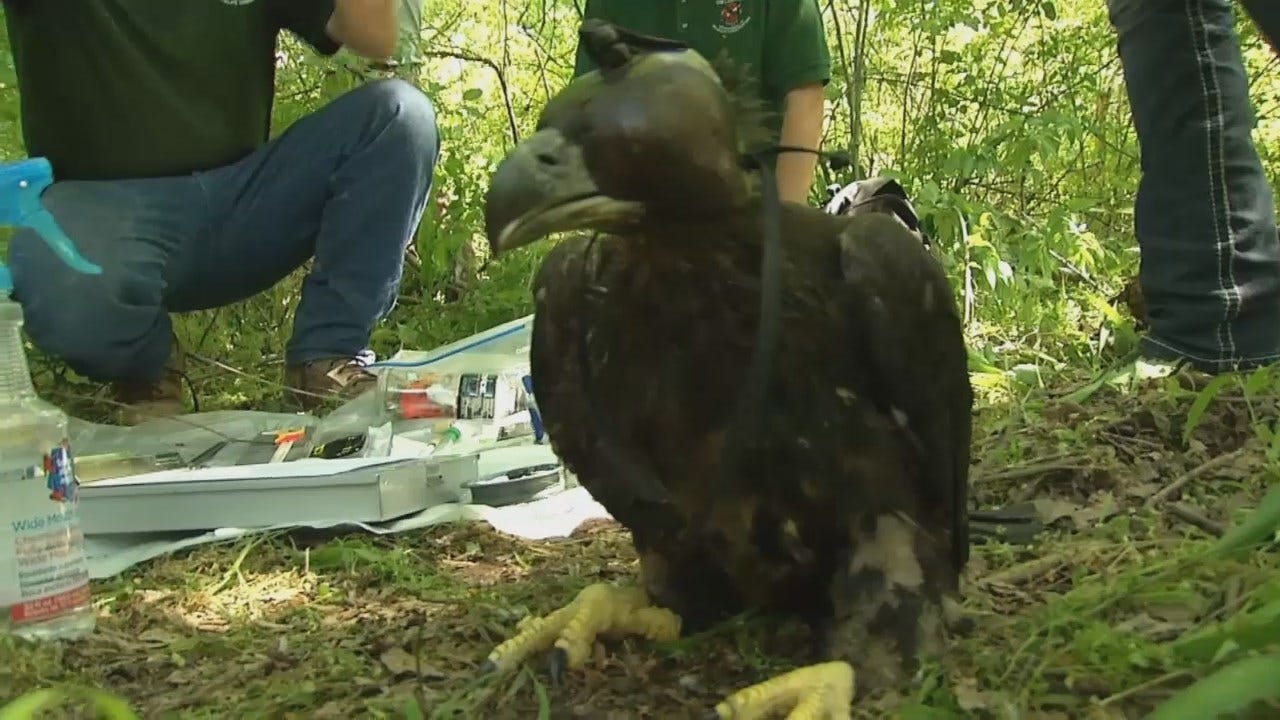Oklahoma Eaglets Part Of Bald Eagle Research Project
<p>There’s still a lot to learn the majestic birds that call Oklahoma home, so researchers went into several nests to track some of Oklahoma’s newest eaglets.</p>Monday, May 23rd 2016, 5:10 pm
Oklahoma is a prime place for eagles because of the many lakes and rivers. Some of them live right near the heart of Tulsa.
But there’s still a lot to learn the majestic birds that call Oklahoma home, so researchers went into several nests to track some of Oklahoma’s newest eaglets.
There are an estimated 120 active bald eagle nests in Oklahoma this spring. One of those elaborate nests is high up in a Cottonwood tree along the Arkansas River near Sand Springs. A team of Oklahoma Department of Wildlife Biologists and U.S. Geological Survey researchers met at the base of that tree in early May.
An expert tree climber secured a rope and repelled to the top of the Cottonwood where two eaglets hatched several weeks before. The climber and his partner research eaglets all over the country. He knows their habits and knows if his presence is putting the chicks in danger.
“If that happens and they start seeing a bird that's acting a little flighty, they'll actually back down just for the safety of the bird,” Wildlife Diversity Specialist Jena Donnell said.
The Arkansas River eaglets were young enough that the climber could safely put them into a bag and lower them to the researchers below.
The eaglets went down one at a time. The first one, a male just shy of 8 weeks, weighed close to 8 pounds and had large talons, but it didn’t have its recognizable features just yet.
“Bald eagles take about 4-4 1/2 years before they get that white head and tail that most people identify with a bald eagle,” Donnell said.
Researchers took blood samples to find out where his parents were born – parents that were flying overhead watching closely.
“They are protective of their nest, but they really don't attack, so they're just kind of keeping an eye on what's going on with their family,” Donnell said.
The male was given an ID band, but he's wasn’t quite big enough to be part of the Wildlife Department's eagle tracking project.
“The trick is that we are really dependent on about a one to two week age window [to equip an eaglet with a harness],” Donnell said.
The male was carefully taken back up to the nest. And his sister was brought down. She got the same workup as the male, but because she was bigger she also got a tracking harness before being returned to the nest.
Attached to the harness was cellular transmitter. It's solar powered and will stay on the life of the bird. Donnell said the equipment has been rigorously tested and research shows that when placed on the right size bird, it will grow into the harness without issue.
The transmitters send data through cell phone towers. They will tell researchers if eagles born in Oklahoma stay in the state or travel to places, like Canada, in the summertime.
“We get a really big flux of migratory birds in the wintertime, Oklahoma's one of the premiere eagle watching sites,” Donnell said.
It will also give flight speeds and flight heights, giving insight to how eagles navigate energy infrastructure.
“Are they really utilizing the main thermals up above to head north, if they go there, or are they staying closer to the land?” Donnell said.
And all that information will help biologists manage the land so our nation's symbol will keep calling Oklahoma home.
“It's incredible to be able to see something so powerful,” Donnell said.
In all, seven Oklahoma eaglets were equipped with a transmitter harness. Researchers expect them to take flight between 10 and 11 weeks old.
The Wildlife Department says it will share progress reports to let folks where their eagles travel.
More Like This
May 23rd, 2016
January 2nd, 2025
September 29th, 2024













